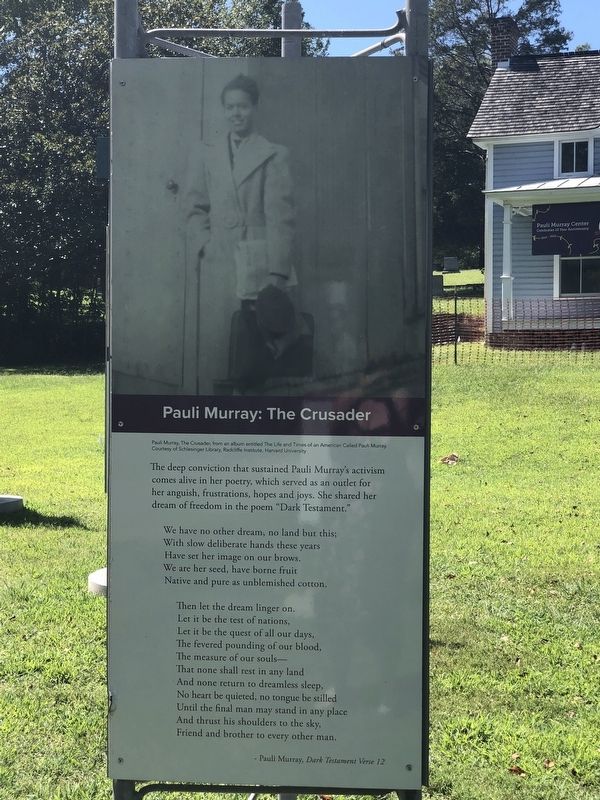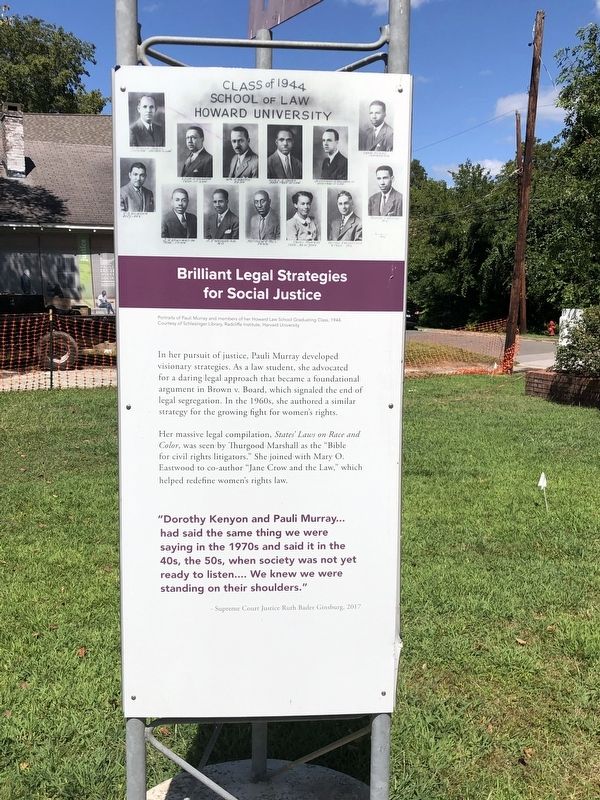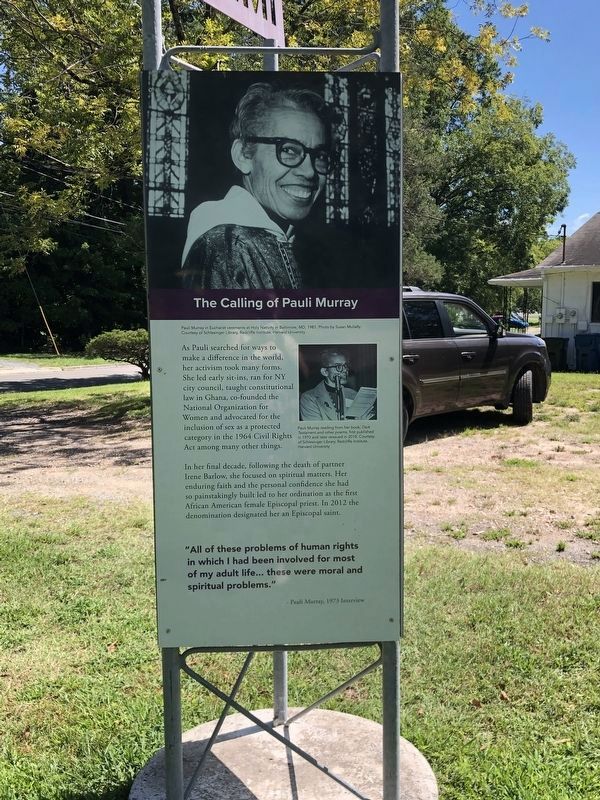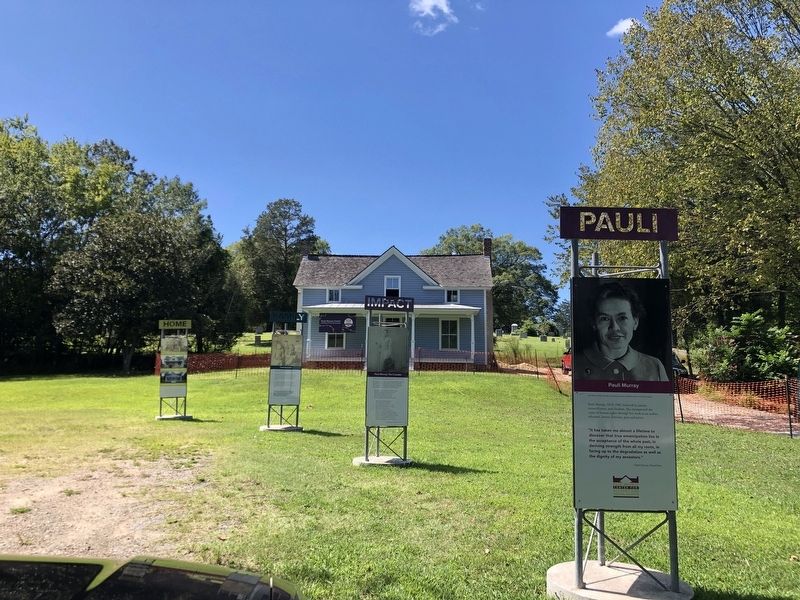West End in Durham in Durham County, North Carolina — The American South (South Atlantic)
Impact
The deep conviction that sustained Pauli Murray's activism comes alive in her poetry, which served as an outlet for her anguish, frustrations, hopes and joys. She shared her dream of freedom in the poem “Dark Testament.”
We have no other dream, no land but this;
With slow deliberate hands these years
Have ser her image on our brows.
We are her seed, have borne fruit
Native and pure as unblemished cotton.
Then let the dream linger on.
Let it be the test of nations,
Let it be the quest of all our days.
The fevered pounding of our blood,
The measure of our souls –
That none shall rest in any land
And none return to dreamless sleep,
No heart be quieted, no tongue be stilled
Until the final man may stand in any place
And thrust his shoulders to the sky,
Friend and brother to every other man.
– Pauli Murray, Dark Testament Verse 12
(Photo caption) Pauli Murray, The Cusader, from an album entitled The Life and Times of an American Called Pauli Murray. Courtesy of Schlesinger Library, Radcliffe Institute, Harvard University
[Second panel] Brilliant Legal Strategies for Social Justice
In her pursuit of justice, Pauli Murray developed visionary strategies. As a law student, she advocated for a daring legal approach that became a foundational argument in Brown v. Board, which signaled the end of legal segregation. In the 1960s, she authored a similar strategy for the growing fight for women's rights.
Her massive legal compilation, States' Laws on Race and Color, was seen by Thurgood Marshall as the “Bible for civil rights litigators.” She joined with Mary O. Eastwood to co-author “Jane Crow and the Law,” which helped redefine women's rights law.
“Dorothy Kenyon and Pauli Murray … had said the same thing we were saying in the 1970s and said it in the 40s, the 50s, when society was not yet ready to listen … We knew we were standing on their shoulders.” – Supreme Court Justice Ruth Bader Ginsburg, 2017
(Photo caption) Portraits of Pauli Murray and members of her Howard Law School Graduating Class, 1944. Courtesy of Schlesinger Library, Radcliffe Institute, Harvard University.
[Third panel] The Calling of Pauli Murray
As Pauli searched for ways to make a difference in the world, her activism took many forms. She led early sit-ins, ran for NY city council, taught constitutional law in Ghana, co-founded the National Organization for Women and advocated for the inclusion of sex as a protected category the 1964 Civil Rights Act among many other things.
In her final decade, following the death of partner Irene Barlow, she focused on spiritual matters. Her enduring faith and the personal confidence she had so painstakingly built led to her ordination as the first African American female Episcopal priest. In 2012 the denomination designated her an Episcopal saint.
“All of these problems of human rights in which I had been involved for most of my adult life…these were moral and spiritual problems.” – Pauli Murray, 1973 interview
[Photo captions]
Top: Pauli Murray in Eucharist vestments at Holy Nativity in Baltimore, MD, 1981. Photo by Susan Mulally. Courtesy of Schlesinger Library, Radcliffe Institute, Harvard University.
Bottom: Pauli Murray reading from her book, Dark Testament and other poems, first published in 1970 and later reissued in 2018. Courtesy of Schlesinger Library, Radcliffe Institute, Harvard University.
Topics. This historical marker is listed in these topic lists: Arts, Letters, Music • Churches & Religion • Civil Rights • Women. A significant historical year for this entry is 2012.
Location. 35° 59.562′ N, 78° 54.964′ W. Marker is in Durham, North Carolina, in Durham County. It is in West End. Marker is on Carroll Street north of Morehead Avenue, on the left when traveling north. Marker is at the Pauli Murray Center for History and Social Justice. Touch for map. Marker is at or near this postal address: 906 Carroll St, Durham NC 27701, United States of America. Touch for directions.
Other nearby markers. At least 8 other markers are within walking distance of this marker. Pauli (here, next to this marker); Family (here, next to this marker); Home (a few steps from this marker); J.T. & Mamie Christian House (approx. ¼ mile away); Pauli Murray (approx. 0.3 miles away); William Albert Wilkerson House (approx. 0.4 miles away); John Sprunt Hill (approx. 0.4 miles away); American Tobacco Trail (approx. 0.6 miles away). Touch for a list and map of all markers in Durham.
Also see . . .
1. Pauli Murray’s Impact & Innovative Legal Spirit. During a civil rights seminar, Murray put forward a groundbreaking yet well-supported idea to overturn Plessy v. Ferguson (1896), a Supreme Court case that ruled segregation is constitutional. Murray argued Plessy v. Ferguson should be frontally attacked, explaining that segregation violated the Fourteenth Amendment’s Equal Protection Clause. (Pauli Murray Center for History and Social Justice) (Submitted on September 10, 2023, by Duane and Tracy Marsteller of Murfreesboro, Tennessee.)
2. Pauli Murray. Durham native the Rev. Dr. Pauli Murray was the first African-American
woman ordained to the Episcopal priesthood. In 2012, she was named to Holy Women, Holy Men by the 77th General Convention of the Episcopal Church and thus became an Episcopal saint. (Episcopal Diocese of North Carolina) (Submitted on September 10, 2023, by Duane and Tracy Marsteller of Murfreesboro, Tennessee.)
Credits. This page was last revised on September 10, 2023. It was originally submitted on September 10, 2023, by Duane and Tracy Marsteller of Murfreesboro, Tennessee. This page has been viewed 55 times since then and 8 times this year. Photos: 1, 2, 3, 4. submitted on September 10, 2023, by Duane and Tracy Marsteller of Murfreesboro, Tennessee.



